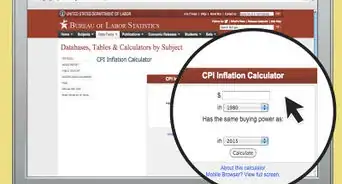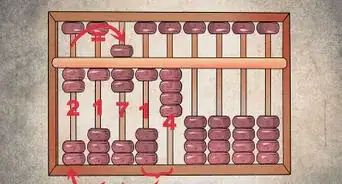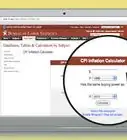wikiHow is a “wiki,” similar to Wikipedia, which means that many of our articles are co-written by multiple authors. To create this article, 37 people, some anonymous, worked to edit and improve it over time.
This article has been viewed 435,686 times.
Learn more...
Perhaps you're trying to answer a question like "If a blouse that originally cost $45 is on sale at 20% off, what is the new price?" These types of questions are called percentage increase/decrease questions, and they're a fairly basic staple of math. With a little help, you can crack them easily and be on your way to doing these in your sleep.
Steps
Perfect Percentage
-
1Use the perfect percentage method for the following sorts of problems: "If a shirt that costs $40 is reduced to $32, what percentage of a discount is this?"
-
2Decide which number represents the original amount and which represents the "after amount." The amount that exists after the percentage has been applied can also be called the "new amount".
- For our question, we do not know the percent. We know that $40 is the original, and that's $32 is the "after."
Advertisement -
3Divide the "after amount" by the original amount. Make sure the "after amount" goes into the calculator first.[1]
- For our example, type 32, hit divide, type 40, hit equals.
- This division gives us: 0.8. (It's not the final answer.)
-
4Move the decimal point two places to the right to change it from a decimal to a percent.[2] For our sample problem, 0.8 changes to 80%.
-
5Compare that percentage to 100%. If your answer is smaller than 100%, you have a decrease or discount; larger than 100% is an increase.
- Because the price in the example dropped, and the price that we calculated is also a discount, we're on the right path.
- If the price in the example dropped from $40 to $32, however, and we got 120% after our calculation, we'd know that something is wrong because we're looking for a discount and we got an increase.
-
6Compare your percentage to 100%. Figure out how much above or below 100% you are and this will be your final answer. In our sample problem, 80% compared to 100% means that we had a discount of 20%.
-
7Practice on the following examples. To get the hang of things, read the prompt and see if you understand how to finish the following problems:
- Problem #1: "A $50 blouse is now $28. What was the percentage of discount?"
- To solve it, grab a calculator. Enter '28,' hit divide, enter '50,' hit equals; the answer is 0.56.
- Convert '0.56' to '56%'. Compare this number to 100%, subtracting '56' from '100', leaving us with a discount of 44%.
- Problem #2: "A $12 baseball cap is $15 after tax. What was the sales tax percentage?"
- To solve it, grab a calculator. Enter '15', hit divide, enter '12', hit equals; the answer is 1.25.
- Convert '1.25' to '125%'. Compare this to 100%, subtracting '100' from '125', leaving us with an increase of 25%.
- Problem #1: "A $50 blouse is now $28. What was the percentage of discount?"
Unknown New Amount
-
1Use the unknown new amount method for the following sorts of problems: "A $25 pair of jeans is on sale at 60% off. What is the sale price?" or "A colony of 4,800 bacteria grows by 20%. How many bacteria are there now?"
-
2Decide if you have an increase or decrease situation. Something like a sales tax, for example, is an increase situation. A discount, on the other hand, is a decrease situation.
-
3If you have an increase situation, add your percent to 100. So an 8% sales tax becomes 108%, for example, or a 12% surcharge becomes 112%.[3]
-
4If you have a decrease situation, subtract your percent from 100. If something is 30% off, you will be working with 70%; if something is discounted 12%, you'll be dealing with 88%.[4]
-
5Convert the answer to Step 3 or Step 4 into a decimal. This means moving the decimal point over two places to the left.
- For example, 67% becomes 0.67; 125% becomes 1.25; 108% becomes 1.08, etc.
- Divide the percentage by 100, and drop the percent mark. This expresses the percentage as a decimal.
-
6Multiply this decimal with your original amount. If, for example, we're working on the problem "A $25 pair of jeans is on sale at 60% off. What is the sale price?" the following is an illustration of this step:
- 25 x .40 = ?
- Remember that we subtracted our sale price of 60% from 100, giving us 40%, and then turned it into a decimal.
-
7Label the increase or decrease appropriately and you're done. For our own example, we last had:
- 25. x .40 = ? Multiply the two numbers together and we get '10'.
- But '10' what? 10 dollars, so we say that the new jeans cost $10 after the 60% sale.
-
8Practice on the following examples. To better understand this type of problem, read the prompt and see if you understand how to finish the following problems:
- Problem #1: "A $120 pair of jeans is on sale at 65% off. What is the sale price?"
- To solve: 100 - 65 gives 35%; 35% converts to 0.35.
- 0.35 x 120 equals 42; the new price is $42 (and quite a deal it is, too!)
- Problem #2: "A colony of 4,800 bacteria grows by 20%. How many bacteria are there now?"
- To solve: 100 + 20 gives 120%; that converts to 1.2.
- 1.2 x 4,800 equals 5,760; there are now 5,760 bacteria in the colony.
- Problem #1: "A $120 pair of jeans is on sale at 65% off. What is the sale price?"
Unknown Original Amount
-
1Use the unknown original amount method for the following sorts of problems: "A video game is on sale at 75% off. The sale price is $15. What was the original price?" or "An investment grew by 22% and is now worth $1525. How much was invested originally?"
- To solve these questions, you must understand that percentages are applied using multiplication. Whether it is an increase or decrease, it was applied using multiplication. Your job, therefore, is to undo that multiplication. You are not undoing the increase or decrease; you are undoing the application of the percentage. Therefore, three things will be true:
- You will be dividing by the percent.
- If you have an increase, you will still add the percentage to 100.
- If you have a decrease, you will still subtract the percentage from 100.
- To solve these questions, you must understand that percentages are applied using multiplication. Whether it is an increase or decrease, it was applied using multiplication. Your job, therefore, is to undo that multiplication. You are not undoing the increase or decrease; you are undoing the application of the percentage. Therefore, three things will be true:
-
2Decide if it's an increase or decrease situation. Sales tax, for example, is an increase; discounts are a decrease. An investment that grows in value is an increase; a population that declines in numbers is a decrease and so forth.
- Let's imagine we have to work out the following problem: "A video is on sale at 75% off. The sale price is $15. What is the original price?"
- Sale is another word for discount, so we're dealing with a decrease.
- $15 is our "after amount," because it's the number we have after the sale has been applied.
-
3If it's an increase, add the percentage to 100. If it's a decrease, subtract the percentage from 100.
- Because we're dealing with a decrease/discount, we'll subtract 100 - 75, giving us 25%.
-
4Convert that number into a decimal. Do this by moving the decimal point two places to the left or dividing the number by 100.
- 25% becomes 0.25.
-
5Divide the "after amount" by the decimal from step 3. This will help us reverse the multiplication that we talked about in Step 1.
-
6Our "after amount" is $15, and our decimal is 0.25.
- Grab a calculator, punch in '15,' hit divide, enter in '0.25,' and hit equals.
-
7Label appropriately and you're done. You've just calculated the original price.
- 15 divided by 0.25 = 60, which means the original price was $60.
- If you want to double-check your answer to make sure it's correct, multiply the sale price (75%, or 0.75) with the original price ($60) and see if you get the sale price.
- ($15): 0.75 x 60 = $45 sale; $60 (original price) - $45 (sale amount) = $15 (sale price)
-
8Practice on the following examples. To better understand this type of problem, read the prompt and see if you understand how to finish the following problem: "An investment grew by 22% and is now worth $1,525. How much was invested originally?"
- This is an increase situation, so add 100 + 22.
- Convert the answer to a decimal: 122% becomes 1.22
- On a calculator, enter '1,525', hit divide, enter '1.22', hit equals.
- Label the answer. For this problem, 1,525 divided by 1.22 = 1250, so the original investment was $1,250.
Community Q&A
-
QuestionIf a number was increased by 15% and the result decreased by 15%, will the number be the previous number or it will be .9775 of the number?
 DonaganTop AnswererIt will be the latter.
DonaganTop AnswererIt will be the latter. -
Question45% increases to 81%. What is the % increase?
 DonaganTop AnswererThis is the same as calculating the percentage of increase from 45 to 81, so you can ignore the percent signs at first. Subtract 45 from 81, and divide that by 45. Then apply the percent sign.
DonaganTop AnswererThis is the same as calculating the percentage of increase from 45 to 81, so you can ignore the percent signs at first. Subtract 45 from 81, and divide that by 45. Then apply the percent sign. -
QuestionWhat percentage of increase is it if a student had a 28% and it was increased to 44%?
 Community AnswerThe fact that the old and new numbers are expressed as percentages is irrelevant. Treat them as you would any numbers: 44 / 28 = 1.57. Multiply by 100: (1.57)(100) = 157. That means the new number is 157% of the old number, which is the same as a 57% increase.
Community AnswerThe fact that the old and new numbers are expressed as percentages is irrelevant. Treat them as you would any numbers: 44 / 28 = 1.57. Multiply by 100: (1.57)(100) = 157. That means the new number is 157% of the old number, which is the same as a 57% increase.
Warnings
- Order of division is crucial! Be sure to put the correct amount into the calculator first.⧼thumbs_response⧽
Things You'll Need
- A calculator.
- Paper
References
- ↑ https://www.skillsyouneed.com/num/percent-change.html
- ↑ https://www.brighthubeducation.com/homework-math-help/38989-changing-decimal-to-percent/
- ↑ https://www.khanacademy.org/math/pre-algebra/pre-algebra-ratios-rates/pre-algebra-percent-word-problems/v/growing-by-a-percentage
- ↑ https://sciencing.com/how-to-calculate-percent-off-13712217.html
About This Article
To work with percentages of increase and decrease, start by dividing the new amount by the original amount. Then, move the decimal point in your answer 2 places to the right to change that number from a decimal to a percentage. If your answer is less than 100, you have a percentage decrease, and if it's greater than 100, you have a percentage increase. To learn how to work with percentages of increase and decrease when you don't know either the new amount or the old amount, scroll down!

















































































